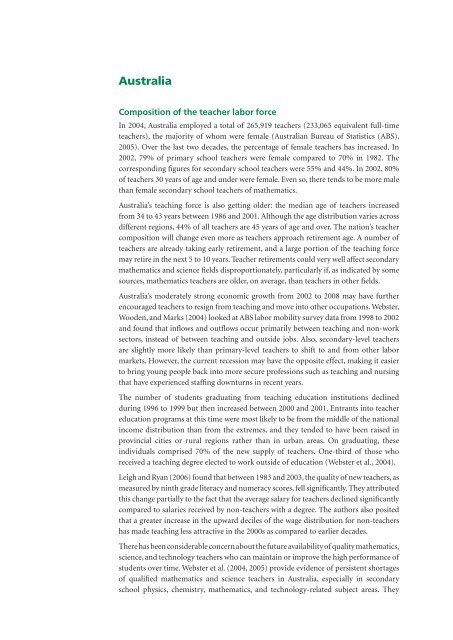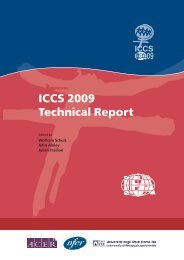Teacher Education and Development Study in Mathematics - IEA
Teacher Education and Development Study in Mathematics - IEA
Teacher Education and Development Study in Mathematics - IEA
Create successful ePaper yourself
Turn your PDF publications into a flip-book with our unique Google optimized e-Paper software.
PART 2:<br />
51<br />
Australia<br />
Composition of the teacher labor force<br />
In 2004, Australia employed a total of 265,919 teachers (233,065 equivalent full-time<br />
teachers), the majority of whom were female (Australian Bureau of Statistics (ABS),<br />
2005). Over the last two decades, the percentage of female teachers has <strong>in</strong>creased. In<br />
2002, 79% of primary school teachers were female compared to 70% <strong>in</strong> 1982. The<br />
correspond<strong>in</strong>g figures for secondary school teachers were 55% <strong>and</strong> 44%. In 2002, 80%<br />
of teachers 30 years of age <strong>and</strong> under were female. Even so, there tends to be more male<br />
than female secondary school teachers of mathematics.<br />
Australia’s teach<strong>in</strong>g force is also gett<strong>in</strong>g older: the median age of teachers <strong>in</strong>creased<br />
from 34 to 43 years between 1986 <strong>and</strong> 2001. Although the age distribution varies across<br />
different regions, 44% of all teachers are 45 years of age <strong>and</strong> over. The nation’s teacher<br />
composition will change even more as teachers approach retirement age. A number of<br />
teachers are already tak<strong>in</strong>g early retirement, <strong>and</strong> a large portion of the teach<strong>in</strong>g force<br />
may retire <strong>in</strong> the next 5 to 10 years. <strong>Teacher</strong> retirements could very well affect secondary<br />
mathematics <strong>and</strong> science fields disproportionately, particularly if, as <strong>in</strong>dicated by some<br />
sources, mathematics teachers are older, on average, than teachers <strong>in</strong> other fields.<br />
Australia’s moderately strong economic growth from 2002 to 2008 may have further<br />
encouraged teachers to resign from teach<strong>in</strong>g <strong>and</strong> move <strong>in</strong>to other occupations. Webster,<br />
Wooden, <strong>and</strong> Marks (2004) looked at ABS labor mobility survey data from 1998 to 2002<br />
<strong>and</strong> found that <strong>in</strong>flows <strong>and</strong> outflows occur primarily between teach<strong>in</strong>g <strong>and</strong> non-work<br />
sectors, <strong>in</strong>stead of between teach<strong>in</strong>g <strong>and</strong> outside jobs. Also, secondary-level teachers<br />
are slightly more likely than primary-level teachers to shift to <strong>and</strong> from other labor<br />
markets. However, the current recession may have the opposite effect, mak<strong>in</strong>g it easier<br />
to br<strong>in</strong>g young people back <strong>in</strong>to more secure professions such as teach<strong>in</strong>g <strong>and</strong> nurs<strong>in</strong>g<br />
that have experienced staff<strong>in</strong>g downturns <strong>in</strong> recent years.<br />
The number of students graduat<strong>in</strong>g from teach<strong>in</strong>g education <strong>in</strong>stitutions decl<strong>in</strong>ed<br />
dur<strong>in</strong>g 1996 to 1999 but then <strong>in</strong>creased between 2000 <strong>and</strong> 2001. Entrants <strong>in</strong>to teacher<br />
education programs at this time were most likely to be from the middle of the national<br />
<strong>in</strong>come distribution than from the extremes, <strong>and</strong> they tended to have been raised <strong>in</strong><br />
prov<strong>in</strong>cial cities or rural regions rather than <strong>in</strong> urban areas. On graduat<strong>in</strong>g, these<br />
<strong>in</strong>dividuals comprised 70% of the new supply of teachers. One-third of those who<br />
received a teach<strong>in</strong>g degree elected to work outside of education (Webster et al., 2004).<br />
Leigh <strong>and</strong> Ryan (2006) found that between 1983 <strong>and</strong> 2003, the quality of new teachers, as<br />
measured by n<strong>in</strong>th grade literacy <strong>and</strong> numeracy scores, fell significantly. They attributed<br />
this change partially to the fact that the average salary for teachers decl<strong>in</strong>ed significantly<br />
compared to salaries received by non-teachers with a degree. The authors also posited<br />
that a greater <strong>in</strong>crease <strong>in</strong> the upward deciles of the wage distribution for non-teachers<br />
has made teach<strong>in</strong>g less attractive <strong>in</strong> the 2000s as compared to earlier decades.<br />
There has been considerable concern about the future availability of quality mathematics,<br />
science, <strong>and</strong> technology teachers who can ma<strong>in</strong>ta<strong>in</strong> or improve the high performance of<br />
students over time. Webster et al. (2004, 2005) provide evidence of persistent shortages<br />
of qualified mathematics <strong>and</strong> science teachers <strong>in</strong> Australia, especially <strong>in</strong> secondary<br />
school physics, chemistry, mathematics, <strong>and</strong> technology-related subject areas. They

















